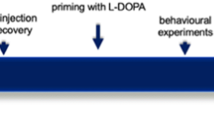Abstract
Deprenyl is a selective monoamine oxidase B (MAO-B) inhibitor and has been used in the treatment of Parkinson's disease. However, it is not known whether deprenyl effects are symptomatic or pharmacological. Aging mice were partially lesioned with MPTP. Control and MPTP-treated mice were given deprenyl in drinking water for 14 days. Brain tissue (including the striatum, olfactory tubercle and cerebral cortex) was assayed for MAO-B and neurotransmitter levels. The results show that deprenyl treatment, given alone or after MPTP, reduced MAO-B activity in all the three regions. No change was seen in dopamine (DA), 3,4-dihydroxyphenyl acetic acid (DO-PAC), and homovanillic acid (HVA) content in any of the three areas. Cortical norepinephrine (NE) levels were also unaltered. However, striatal serotonin (5-HT) levels were decreased while its metabolite, 5-HIAA levels were significantly increased in the olfactory tubercle in animals receiving deprenyl alone. These data suggest that deprenyl treatment reduces MAO-B activity in regions in addition to the striatum without affecting norepinephrine, dopamine (DA) and its metabolites.
Similar content being viewed by others
References
Langston, J. W., Ballard, P., Tetrud, J. W., and Irwin, I. 1983. Chronic parkinsonism in humans due to a product of meperidineanalog synthesis. Science 219:979–980.
Burns, R. S., Chiueh, C. C., Markey, S. P., Ebert, M. H., Jacobowitz, D. M., and Kopin, I. J. 1983. A primate model of parkinsonism: selective destruction of dopaminergic neurons in the pars compacta of the substantia nigra by n-methyl-4-phenyl-1,2,3,6-tetrahydropyridine. Proc. Natl. Acad. Sci. USA 80:4546–4550.
Gupta, M., Felten, D. L., and Gash, D. M. 1984. MPTP alters central catecholamine neurons in addition to the nigrostriatal system. Brain Res. Bull. 13:737–742.
Gupta, M., Gupta, B. K., Thomas, R., Bruemmer, V., Sladek, J. R. Jr., and Felten, D. L. 1986. Aged mice are more sensitive to MPTP treatment than young adults. Neurosci. Lett. 70:326–331.
Chiba, K., Trevor, A. J., and Castagnoli, N. Jr. 1984. Metabolism of the neurotoxic tertiary amine, MPTP, by brain monoamine oxidase. Biochem. Biophys. Res. Commun. 120:574–578.
Cohen, G., Pasik, P., Cohen, B., Leist, A., Mytilineou, C., and Yahr, M. D. 1985. Pargyline and deprenyl prevent the toxicity of MPTP in monkeys. Eur. J. Pharmacol. 106:209–210.
Shoulson, I. and the Parkinson Study Group 1989. Deprenyl and tocopherol antioxidative therapy of parkinsonism (DATATOP). Acta Neurol. Scand. 126:171–175.
The Parkinson Study Group 1989. Effect of deprenyl on the progression of disabilitu in early Parkinson's Disease. N. Engl. J. Med. 321(20):1364–1371.
Ingram, D. K., Wiener, H. L., Chachich, M. E., Long, J. M., Hengemihle, J., and Gupta, M. 1993. Chronic treatment of aged mice with L-deprenyl produces marked striatal MAO-B inhibition but no beneficial effects on survival, motor performance, or nigral lipofuscin accumulation. Neurobiol. Aging 14:431–440.
Wiener, H. L., Hashim, A., Lajtha, A., and Sershen, H. 1989. Chronic L-deprenyl does not alter the restoration of striatal dopamine in MPTP-lesioned mice. J. Neurosci. Res. 23:326–329.
Naoi, M., and Nagatsu, T. 1986. Inhibition of monoamine oxidase by 3,4-dihydroxyphenyl serine. J. Neurochem. 47:604–607.
Sershen, H., Hashim, A., and Lajtha, A. 1987. Behavioral and biochemical effects of nicotine in an MPTP-induced mouse model of Parkinson's disease. Pharmacol. Biochem. Behav. 28:299–303.
Bradford, M. 1976. A rapid and sensitive method for the quantitation of microgram quantities of protein utilizing the principle of protein-dye binding. Anal. Biochem. 72:248–254.
Trevor, A. J., Singer, T. P., Ramsay, R. R., and Castagnoli, N. J. 1987. Processing of MPTP by monoamine oxidase: implications for molecular toxicology. J. Neural Transm. Suppl. 23:73–89.
Zsilla, G., Barbaccia, M. L., Gandolfi, O., Knoll, J., and Costa, E. 1983. (-)-Deprenyl a selective MAO ‘B’ inhibitor increases [3H] imipramine binding and decreases β-adrenergic receptor function. Eur. J. Pharmacol. 89:111–117.
Fowler, C. J., Tipton, K. F., MacKay, A. V. P. and Youdim, M. B. H. 1982. Human platelet monoamine oxidase-A useful enzyme in the study of psychiatric disorder. Neuroscience 7:1577.
Mann, J., and Gerson, S. 1980. (L)-Deprenyl, a selective monoamine oxidase type B ihibitor in endogenous depression. Life Sci. 26:877.
Author information
Authors and Affiliations
Rights and permissions
About this article
Cite this article
Gupta, M., Wiener, H.L. Effects of deprenyl on monoamine oxidase and neurotransmitters in the brains of MPTP-treated aging mice. Neurochem Res 20, 385–389 (1995). https://doi.org/10.1007/BF00973091
Accepted:
Issue Date:
DOI: https://doi.org/10.1007/BF00973091




